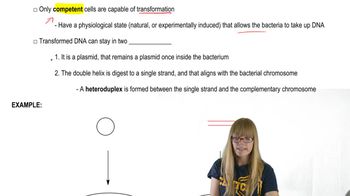Table of contents
- 1. Introduction to Genetics51m
- 2. Mendel's Laws of Inheritance3h 37m
- 3. Extensions to Mendelian Inheritance2h 41m
- 4. Genetic Mapping and Linkage2h 28m
- 5. Genetics of Bacteria and Viruses1h 21m
- 6. Chromosomal Variation1h 48m
- 7. DNA and Chromosome Structure56m
- 8. DNA Replication1h 10m
- 9. Mitosis and Meiosis1h 34m
- 10. Transcription1h 0m
- 11. Translation58m
- 12. Gene Regulation in Prokaryotes1h 19m
- 13. Gene Regulation in Eukaryotes44m
- 14. Genetic Control of Development44m
- 15. Genomes and Genomics1h 50m
- 16. Transposable Elements47m
- 17. Mutation, Repair, and Recombination1h 6m
- 18. Molecular Genetic Tools19m
- 19. Cancer Genetics29m
- 20. Quantitative Genetics1h 26m
- 21. Population Genetics50m
- 22. Evolutionary Genetics29m
7. DNA and Chromosome Structure
DNA as the Genetic Material
Problem 1
Textbook Question
What results from the experiments of Frederick Griffith provided the strongest support for his conclusion that a transformation factor is responsible for heredity?
 Verified step by step guidance
Verified step by step guidance1
Understand the context of Frederick Griffith's experiments: Griffith was studying two strains of the bacterium *Streptococcus pneumoniae*—a smooth (S) strain, which is virulent, and a rough (R) strain, which is non-virulent.
Recall the key experimental setup: Griffith injected mice with different combinations of these bacterial strains, including live R strain, live S strain, heat-killed S strain, and a mixture of live R strain with heat-killed S strain.
Focus on the critical observation: Mice injected with the mixture of live R strain and heat-killed S strain developed pneumonia and died, and live S strain bacteria were recovered from their bodies.
Interpret the results: The transformation of the non-virulent R strain into the virulent S strain suggested that some 'transforming factor' from the heat-killed S strain was transferred to the R strain, enabling it to acquire the virulent properties.
Conclude the significance: This experiment provided strong evidence that the 'transforming factor' was responsible for heredity, laying the groundwork for identifying DNA as the genetic material in later experiments.
 Verified video answer for a similar problem:
Verified video answer for a similar problem:This video solution was recommended by our tutors as helpful for the problem above
Video duration:
5mPlay a video:
Was this helpful?
Key Concepts
Here are the essential concepts you must grasp in order to answer the question correctly.
Griffith's Experiment
Frederick Griffith conducted experiments in 1928 using two strains of Streptococcus pneumoniae: a virulent strain with a smooth appearance and a non-virulent strain with a rough appearance. He discovered that when he injected mice with heat-killed virulent bacteria mixed with live non-virulent bacteria, the mice developed pneumonia and died. This indicated that some 'transforming principle' from the dead bacteria was taken up by the live bacteria, transforming them into a virulent form.
Recommended video:
Guided course

Mendel's Experiments
Transformation
Transformation is a process in which a bacterium takes up foreign DNA from its environment and incorporates it into its own genome. In Griffith's experiment, the non-virulent bacteria acquired the genetic material from the heat-killed virulent bacteria, leading to a change in phenotype. This concept is fundamental in genetics as it demonstrates how genetic information can be transferred between organisms, influencing traits and characteristics.
Recommended video:
Guided course

Transformation
Avery-MacLeod-McCarty Experiment
Building on Griffith's findings, the Avery-MacLeod-McCarty experiment in 1944 identified DNA as the 'transforming factor.' By treating the heat-killed virulent bacteria with enzymes that destroyed proteins, RNA, or DNA, they showed that only the destruction of DNA prevented transformation in the non-virulent bacteria. This provided strong evidence that DNA is the molecule responsible for heredity, supporting Griffith's initial conclusions about the transformation factor.
Recommended video:
Guided course

Mendel's Experiments

 9:32m
9:32mWatch next
Master History and Experiments with a bite sized video explanation from Kylia
Start learningRelated Videos
Related Practice
Multiple Choice
Genes contain instructions for assembling which of the following macromolecules?
2
views
